Services › Local Elections › Local Authority Election Statistics 2022
- Background
- 2022 Local Authority Election Statistics
- 2022 Local Authority Election Trends
- Previous Local Authority Election Statistics
Background
The Department compiles voting statistics from local authority elections (local elections), which are held every three years. Local authorities include city, district and regional councils, community boards, local boards, and trusts (such as licensing trusts).The 2022 local election is the twelfth since the restructuring of local government in 1989. The 1989 local election is the base year for comparisons.
The Electoral Commission provides information on turnout at General Elections.
2022 Local Authority Election Statistics
The 2022 local elections statistics are sourced primarily from a questionnaire sent to all electoral officers. Information for each electoral ward/constituency includes the number of eligible voters, number of actual voters, number of special and invalid votes, number of candidates, number of sitting members seeking re-election, number of female candidates, and number of women elected.The statistics are provided as open data, in the form of spreadsheets. Releasing the statistics in this form makes the information more accessible to, and useable by, interested parties (such as government agencies, councils, and researchers).
The prepared statistics represent the official record of voter turnout for local elections. To ensure accuracy, the data was carefully reviewed and checked. However, due to the volume and number of sources involved in the data collection, there may be some errors which are beyond our control.
The Department thanks all electoral officers for providing the data. The Department would also like to thank Local Government New Zealand and Taituarā for their assistance with this project.
2022 Local Authority Election Trends
Voter turnout (turnout) and the representation of women as candidates and elected members are the most commonly requested local elections statistics. Charts illustrating these trends over the last 34 years are shown below. Corresponding brief descriptions of these statistics are in the form of proportions, identifying and comparing these across local elections.Voter turnout
The Voter Turnout axis represents the percentage of total voters in total electors on the roll.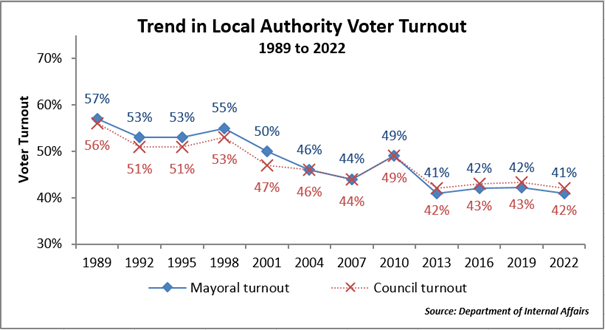
Note: Mayoral turnout includes contested elections of mayors for city and district councils. Council turnout covers contested city, district, and regional council elections. Uncontested elections are not included in this statistic.
Since the nationwide restructuring of local government in 1989, turnout has declined from 56 percent to 42 percent in 2022. Results over the past four elections show an overall stabilisation in turnout of around 42 to 43 percent.
Higher turnout in the 2010 elections is partly attributed to increased local voting for the first Auckland “super city” election, and in Christchurch following the 2010 Canterbury earthquake.
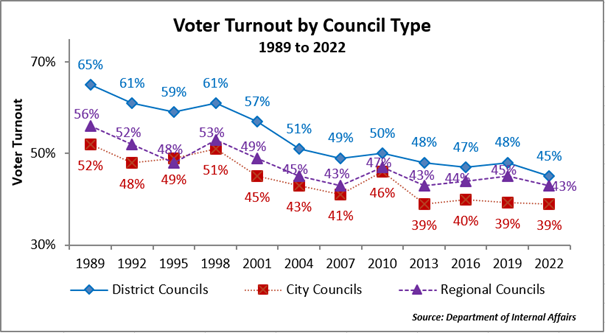
Note: Voter turnout based on councillor elections for city, district, and regional councils.
While turnout for all council types has declined since 1989, turnout is higher for district councils (45% in 2022) than for regional or city councils (43% and 39% respectively).
Representation of women
For the representation of women as candidates and elected members, the proportion axis shows the percentage of female candidates and elected members in all candidates and elected members respectively.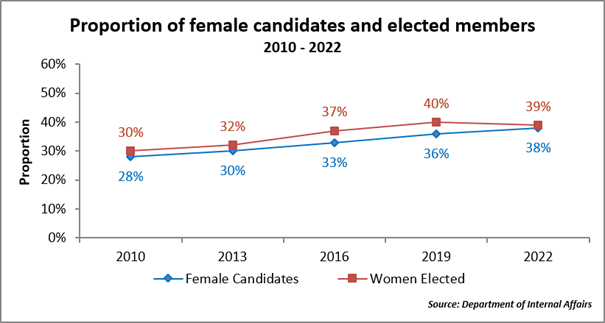
Note: This chart covers the local authority elections examined in this report, including mayoralties, councils, community boards, and local boards.
Since 2010, the proportion of women elected to local authorities is continuously rising, although there is a slight decrease shown for 2022. The 2019 and 2022 results respectively show the highest percentage of female elected members and candidates out of the total group of elected members and candidates in the last 13 years. In 2022, women made up 39 percent of elected members and 38 percent of candidates.
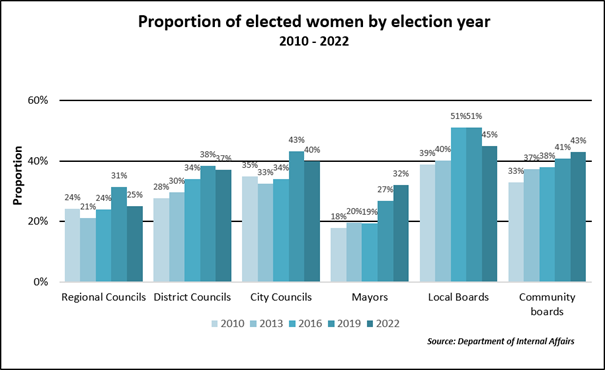
The proportion of women elected to most of the examined areas of local government is steadily increasing from 2010 to 2019. The 2022 local elections show a decreased proportion of women, with the exception of mayors and community boards. The parts of local government where female elected members reduced most significantly are regional councils (-6% to 25%, this is equivalent to 7 less members) and local boards (-6% to 45%, 9 less members). Notwithstanding this, local boards still have the largest representation of elected women overall, with nearly half of electable positions held by women following the 2022 local elections. Similar to preceding years, mayors and community boards saw increases in the proportion of women elected. This was especially prominent in the role of mayor, which increased from 27 percent to 32 percent.
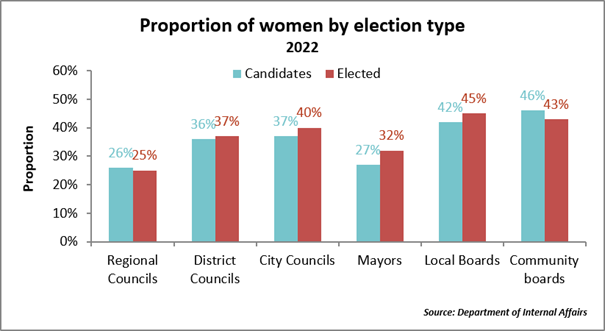
The biggest difference between the proportion of candidates versus the proportion of elected members is for mayors. Although women made up 27 percent of the total candidate pool, they won nearly a third (32%) of the electable positions. Women also had a higher proportion of elected members for most of the examined areas of local government included in the 2022 local elections, excluding regional councils and community boards.
The full data set, including the above graphs and 2022 local elections statistics, can be downloaded as an Excel file by clicking the following link:
- Local Authority Election Statistics 2022 (Excel, 346 kb)
- 2022 Local Authority Election Data (CSV, 123 kb)
Previous Local Authority Election Statistics
Data
The 2019 data set, including graphs and the 2019 local elections statistics, can be downloaded as an Excel file by clicking the following link:- Local Authority Election Statistics 2019 (Excel, 294 kb)
- 2019 Local Authority Election Data (CSV, 134 kb)
- 2016 Local Authority Election Data (CSV, 1.6 mb)
- 2013 Local Authority Election Data (CSV, 189 kb)
- 2010 Local Authority Election Data (CSV, 202 kb)